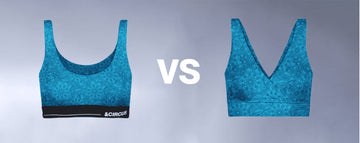In the vibrant chaos of Mumbai's markets, where colors clash and trends collide, something subtle yet profound is shifting in the way Indians approach their most personal layer of clothing. Innerwear, long relegated to the shadows of fashion discourse, is emerging as a powerhouse of wellness innovation. No longer just functional necessities, bras, briefs, and baselayers are becoming symbols of self-care, body positivity, and health-conscious living. From the tech hubs of Bengaluru to the textile looms of Tiruppur, this evolution is reshaping wardrobes across the nation, blending style with substance in ways that resonate deeply with modern consumers.
Uncomfortable underwear shouldn't steal your confidence. At Andcircus, we craft ultra-soft, sustainable Lenzing Modal Micro® innerwear for every body, XS to 5XL. From briefs to bras, our custom packs fit you perfectly. Shop risk-free with our 100% satisfaction guarantee and embrace comfort that includes everyone. #LoveEveryBody. Shop Now!
Wellness Meets Wardrobe: A New Era for Innerwear
The intimate apparel landscape in India is experiencing a seismic transformation. Urban dwellers in Maharashtra, Karnataka, and Delhi are no longer content with mere aesthetics; they seek innerwear that bolsters posture, accommodates maternity requirements, and incorporates breathable, wellness-oriented materials. This demand mirrors a global shift where everyday clothing increasingly incorporates athletic elements, fostering versatility and comfort.
Drawing from broader market insights, the global athleisure market, encompassing wellness-infused innerwear, stood at USD 431.70 billion in 2024 and is anticipated to climb to approximately USD 1,069.84 billion by 2034, advancing at a compound annual growth rate of 9.5% between 2025 and 2034. In 2025, its revenue is pegged at USD 472.71 billion, propelled by the dissolving lines between casual attire and sportswear. While North America held a substantial USD 126.16 billion share in 2023, Asia Pacific, including India, is poised as the swiftest expanding region, fueled by rising health awareness and urban lifestyles.
In Mumbai and Bengaluru, shoppers are flocking to options that fuse practicality with elegance think ergonomic bras that alleviate back strain or moisture-absorbent boxer shorts that promote all-day freshness. This movement extends beyond metros, infiltrating Tier-2 locales in Uttar Pradesh and Gujarat, where inclusive sizing caters to diverse body types, promoting confidence and well-being. The surge in e-commerce has amplified this accessibility, allowing brands to reach remote areas with tailored wellness-focused lines.
Globally, the innerwear sector echoes this momentum. It amassed USD 213,619.7 million in revenue during 2023 and is forecasted to expand to USD 310,021.2 million by 2030, achieving a CAGR of 5.5% from 2024 onward. Bottom innerwear dominated with USD 108,436.8 million in 2023, but thermal and baselayers emerge as the most dynamic segment, reflecting a pivot toward functional, health-enhancing products. Asia Pacific led as the top revenue contributor in 2023, underscoring India's pivotal role in this growth narrative.
Trends Shaping India's Innerwear Revolution
Tiruppur in Tamil Nadu, India's textile epicenter, is at the vanguard of infusing wellness into fabric production. Manufacturers here are championing organic cotton and bamboo composites, celebrated for their gentle touch and airiness ideal for sensitive skin and humid climates. These aren't fleeting fads; they address a burgeoning call for eco-friendly, non-irritating garments that align with sustainable living.
In Kolkata, lingerie producers are shifting gears toward wireless, anatomically designed bras positioned as vital wellness items. Engineered to minimize tension and boost ease during extended hours, these innovations cater to the demands of professional women. Similarly, in Haryana's Manesar industrial zone, shapewear featuring alignment-correcting inserts is surging in appeal, merging therapeutic advantages with modern contours for career-oriented individuals.
Maternity and lactation apparel are staking a strong claim too. In Kerala and Telangana, medical facilities and specialty stores are teaming up with labels to deliver post-delivery bras emphasizing stability and convenience. This caters to the uptick in city births, forging a lucrative niche. For instance, the global innerwear market, inclusive of these wellness niches, highlights Asia Pacific's dominance, with India driving innovation through localized partnerships.
Technology integration is revolutionizing the field. Delhi's research facilities are pioneering fabrics that repel sweat and regulate body heat, perfectly suited to India's varied weather patterns. Bengaluru's upscale shops are assembling "wellness fashion" assortments, amplified via Instagram influencers who portray innerwear as an extension of personal health regimens. Softness has become the benchmark in India's undergarment scene, with experts asserting that comfort and eco-friendliness will dictate future directions.
India's innerwear industry is entering a transformative phase, shaped by shifting lifestyles, evolving aesthetics, and rising digital adoption. Bottomwear remains the key growth engine, fueled by demand for comfort-centric designs and affordable luxury. Meanwhile, lingerie is fast emerging as a symbol of self-expression and functionality, supported by growing awareness of fit and fabric innovation. The acceleration of online retail is amplifying this momentum platforms and direct-to-consumer brands are redefining access, offering inclusive sizing, eco-conscious materials, and personalized shopping experiences. Together, these trends are stitching a new narrative for India's innerwear economy one that balances modernity, inclusivity, and mindful consumption.
Wellness trends are amplifying this expansion. Consumers prioritize moisture-repelling, seamless constructions, and green materials, alongside broader sizing for inclusivity. Emphasis on comfort over traditional push-up styles is evident, with sustainable options like organic cotton and bamboo gaining ground. Fifty-three percent of Indians actively enhance their health, influencing apparel choices toward transparent, wellness-aligned products.
Real Stories, Real Impact
Stroll through Bengaluru's Indiranagar boutiques, and you'll encounter displays categorized by utility anti-friction, spine-supporting, or temperature-balancing. These outlets capitalize on the area's digitally adept, health-focused populace, framing undergarments as self-nurturing essentials. In Kolkata, a boutique lingerie maker recently garnered attention with physiotherapist-collaborated wire-free bras, tackling desk-related discomfort for office workers.
Parallels exist internationally. The U.S. innerwear market posted USD 27,968.3 million in 2023, eyeing USD 39,707.1 million by 2030 at a 5.1% CAGR. Bottom innerwear led, but thermal baselayers grow quickest, mirroring India's push for practical layers. This global pivot bolsters men's wellness innerwear in India, especially in Delhi NCR fitness venues, where chafe-resistant, supportive designs appeal to active lifestyles.
In India, the athleisure segment, intertwined with innerwear, valued at USD 13,156.1 million in 2024, is slated to reach USD 21,250.2 million by 2033, with a 5.5% CAGR from 2025. Activewear anticipates a 12.2% CAGR from 2025 to 2030. Launches like Jockey's JKY Groove in May 2025 target youthful demographics with trendy, comfy athleisure.
Challenges on the Horizon
Amid this progress, obstacles persist. High-end materials like bamboo remain pricey, sidelining buyers in cost-conscious regions such as Uttar Pradesh and West Bengal. Societal taboos in rural Gujarat and Haryana stifle open dialogue on intimate wellness, curbing adoption. Supply bottlenecks plague Tamil Nadu and Delhi, with reliance on foreign tech fabrics hampering local output.
Nevertheless, ingenuity prevails. Maharashtra's online-native brands harness platforms like Flipkart for budget-friendly wellness ranges. In Kerala, maternity specialists partner with clinics to demystify postpartum wear, fusing awareness with commerce. These strategies mitigate barriers, fostering broader market penetration.
Opportunities for Growth
Prospects abound. The maternity arena, spurred by urban demographics in Telangana and Kerala, invites expansion via medically endorsed, chic nursing gear. Men's segment evolves, with Delhi gyms fueling interest in ergonomic, anti-irritation trunks. Digital commerce accelerates this brands in Maharashtra and Karnataka exploit Instagram for targeted outreach to millennials.
Exports shine brightly. Tiruppur's ecosystem eyes South Asian markets for wellness lingerie, leveraging regional health trends. With India's apparel sector projected at USD 146.3 billion by 2032, and female innerwear doubling to USD 11-12 billion by 2025, the industry is primed for substantial gains.
A Future Woven with Wellness
As India's innerwear evolves, fusing style and utility becomes paramount. Insights from Delhi academies and Maharashtra councils foresee wellness as the bedrock by 2030, with AI sizing and custom fits revolutionizing retail. From Tiruppur's mills to Bengaluru's stores, labels reposition innerwear as empowerment vehicles nurturing physiques, elevating spirits, and honoring local nuances.
The imperative remains equilibrium: ensuring affordability, cultural fit, and availability across states like Maharashtra, Karnataka, Tamil Nadu, Delhi, Telangana, Uttar Pradesh, Gujarat, Haryana, Kerala, and West Bengal. As threads of progress and empathy intertwine, India's innerwear saga unfolds, attiring the populace for a vital, assured tomorrow.
Frequently Asked Questions
What is wellness innerwear and why is it becoming popular in India?
Wellness innerwear refers to intimate apparel that goes beyond basic functionality to incorporate health-enhancing features like posture support, moisture-wicking materials, and ergonomic designs. In India, this trend is gaining momentum as urban consumers in cities like Mumbai, Bengaluru, and Delhi prioritize self-care and body positivity, seeking undergarments that offer therapeutic benefits alongside comfort and style.
How is the Indian innerwear market growing and what are the key trends?
India's innerwear market is projected to grow at a CAGR of 7.6% from 2024 to 2030, reaching USD 19.25 billion by 2033. Key trends include the adoption of sustainable materials like organic cotton and bamboo, wireless and anatomically-designed bras, temperature-regulating fabrics, and inclusive sizing options. The online lingerie segment alone is expected to increase by USD 591.6 million between 2025 and 2029.
What materials and technologies are being used in wellness-focused innerwear?
Modern wellness innerwear incorporates advanced materials such as organic cotton, bamboo composites for breathability and skin sensitivity, moisture-wicking fabrics, and temperature-regulating technologies. Manufacturing hubs like Tiruppur in Tamil Nadu are leading the production of these eco-friendly, non-irritating garments, while research facilities in Delhi are developing sweat-repelling and heat-regulating fabrics specifically suited to India's diverse climate conditions.
Disclaimer: The above helpful resources content contains personal opinions and experiences. The information provided is for general knowledge and does not constitute professional advice.
You may also be interested in: Bikini Briefs vs Thongs Briefs for Women: Which is Better?
Uncomfortable underwear shouldn't steal your confidence. At Andcircus, we craft ultra-soft, sustainable Lenzing Micro Modal innerwear for every body, XS to 5XL. From briefs to bras, our custom packs fit you perfectly. Shop risk-free with our 100% satisfaction guarantee and embrace comfort that includes everyone. #LoveEveryBody. Shop Now!







































